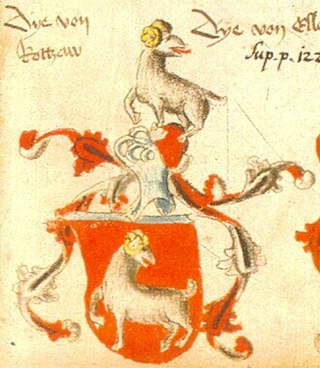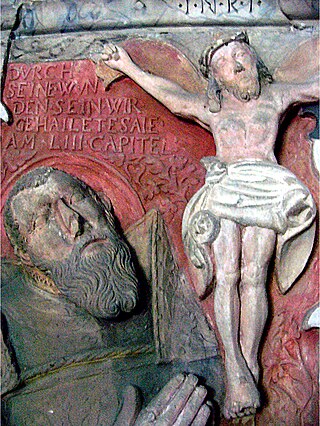
Frederick I of Ansbach and Bayreuth was born at Ansbach as the eldest son of Albert III, Margrave of Brandenburg by his second wife Anna, daughter of Frederick II, Elector of Saxony. His elder half-brother was the Elector John Cicero of Brandenburg. Friedrich succeeded his father as Margrave of Ansbach in 1486 and his younger brother Siegmund as Margrave of Bayreuth in 1495.

George Frederick of Brandenburg-Ansbach was Margrave of Ansbach and Bayreuth, as well as Regent of Prussia. He was the son of George, Margrave of Brandenburg-Ansbach and a member of the House of Hohenzollern. He married firstly, in 1559, Elisabeth of Brandenburg-Küstrin. He married secondly, in 1579, Sophie of Brunswick-Lüneburg, daughter of William of Brunswick-Lüneburg and Dorothea of Denmark.
Kulmbach is a Landkreis (district) in Bavaria, Germany. It is bounded by the districts of Kronach, Hof, Bayreuth and Lichtenfels.

Hof is a town on the banks of the Saale in the northeastern corner of the German state of Bavaria, in the Franconian region, at the Czech border and the forested Fichtel Mountains and Franconian Forest upland regions. The town has 47,296 inhabitants, the surrounding district an additional 95,000.

Kulmbach is the capital of the district of Kulmbach in Bavaria in Germany. The town, once a stronghold of the Principality of Bayreuth, is renowned for its massive Plassenburg Castle, which houses the largest tin soldier museum in the world, and for its sausages, or Bratwürste.

The Principality of Bayreuth or Margraviate of Brandenburg-Bayreuth was an immediate territory of the Holy Roman Empire, ruled by a Franconian branch of the Hohenzollern dynasty. Since Burgrave Frederick VI of Nuremberg was enfeoffed with the Margraviate of Brandenburg in 1415/17, the Hohenzollern princes transferred the margravial title to their Franconian possessions, though the principality never had been a march. Until 1604 they used Plassenburg Castle in Kulmbach as their residence, hence their territory was officially called the Principality of Kulmbach or Margraviate of Brandenburg-Kulmbach until the Empire's dissolution in 1806.
Frederick V of Nuremberg was a Burgrave (Burggraf) of Nuremberg, of the House of Hohenzollern.

The Burgraviate of Nuremberg was a state of the Holy Roman Empire from the early 12th to the late 15th centuries. As a burgraviate, it was a county seated in the town of Nuremberg; almost two centuries passed before the burgraviate lost power over the city, which became independent from 1219. Eventually, the burgraviate was partitioned to form Brandenburg-Ansbach and Brandenburg-Bayreuth.

Casimirof Brandenburg-Bayreuth was Margrave of Bayreuth or Margrave of Brandenburg-Kulmbach from 1515 to 1527.

John, nicknamed the Alchemist was a Margrave of Brandenburg-Kulmbach and served as the peace-loving Margrave of Brandenburg after the abdication of his father, Frederick I, the first member of the House of Hohenzollern to rule Brandenburg.
The Second Margrave War was a conflict in the Holy Roman Empire between 1552 and 1555. Instigated by Albert Alcibiades, Margrave of Brandenburg-Kulmbach and Brandenburg-Bayreuth, who was attempting to form a Duchy of Franconia under his rule, the war resulted in widespread devastation in Franconia, while also affecting the Rhineland and Lower Saxony.

The House of Andechs was a feudal line of German princes in the 12th and 13th centuries. The counts of Dießen-Andechs obtained territories in northern Dalmatia on the Adriatic seacoast, where they became Margraves of Istria and ultimately dukes of a short-lived imperial state named Merania from 1180 to 1248. They were also self-styled lords of Carniola.

The House of Kotzau was an old minor German noble family in Franconia, Germany.

Georg Wolf of Kotzau, nicknamed the rich was an Imperial Knight and Amtmann and Governor.
The Bavarian War from 1459 to 1463, also known as the Princes' War, was a result of the expansionist ambitions of the two warring Principalities, pitting Margrave, later Elector, Albert Achilles from the House of Hohenzollern, which by this time had already annexed the principalities of Brandenburg-Kulmbach and Brandenburg-Ansbach, against Duke Louis "the Rich" of Bavaria-Landshut from the House of Wittelsbach.
Herman II, Count of Weimar-Orlamünde was a member of the House of Ascania. He ruled the County of Weimar-Orlamünde from 1206 until his death.
Beatrix of Merania was a princess of Merania by birth, and the Countess of Weimar-Orlamünde by marriage.

Otto III. Weimar-Orlamünde, sometimes called Otto IV was a German nobleman. He was a member of the House of Ascania and a titular Count of Weimar-Orlamünde. He was the ruling Count of Weimar and Lord of Rudolstadt and Plassenburg.

Berthold II of Andechs, a member of the House of Andechs, was a German nobleman. He was a ruling count of Dießen and Andechs in the Duchy of Bavaria, of Plassenburg and Kulmbach in Franconia, as well as bailiff of Benediktbeuern Abbey.

Himmelkron Abbey is located in Himmelkron in the district of Kulmbach in Upper Franconia, Germany. From the 13th to the 16th century it was a Cistercian abbey in the Archdiocese of Bamberg. It then served the Margraviate of Brandenburg-Bayreuth as a summer residence and Jagdschloss until the 19th century. Today it is a residential home and day care center for people with intellectual disabilities.














